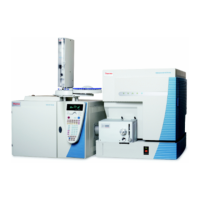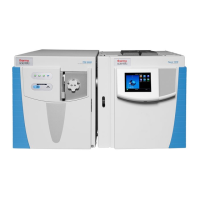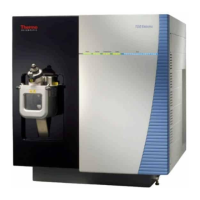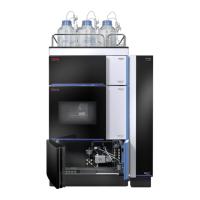Do you have a question about the Thermo Scientific TSQ Quantis and is the answer not in the manual?
Describes the TSQ Altis, TSQ Quantis, and TSQ Fortis MS models.
Details the mass-to-charge ratio detection ranges for TSQ Altis, Quantis, and Fortis MS.
Provides a block diagram of the MS hardware components and their functions.
Explains how ion optic assemblies and mass analyzer assemblies control ion path.
Details the function of forepumps and turbomolecular pumps in the vacuum system.
Describes the vacuum manifold as a chamber enclosing MS components.
Presents a functional block diagram of the Altis vacuum system.
Explains the three types of vacuum gauges used in the MS.
Details components of the API source interface, including sweep cone and transfer tube.
Describes the ion transfer tube's function and different designs for MS systems.
Explains the function of RF and exit lenses in ion transmission.
Details the MP00 RF lens and L0 lens for guiding ions.
Explains MP0 ion optics, beam blocker for neutral species removal.
Describes the ion detection system including conversion dynode and electron multiplier.
Procedure for turning the MS system on via the Tune window.
Steps to put the MS into standby mode for short-term inactivity.
Procedure for emergency shutdown using the main power switch.
Procedure for completely shutting down the MS system for extended periods.
Instructions for powering down associated system components.
Procedures for restarting the data system computer.
How to reset the MS using the reset button on the communications panel.
Procedure for achieving sufficient vacuum after a shutdown.
Guidance on resetting calibration parameters to factory defaults.
Tasks to ensure the MS is ready for operation, including leak checks.
Procedures for after-operation tasks like flushing and purging.
Steps to prepare the syringe pump for calibration with EMRS solution.
Procedure for setting up the MS for calibration in the Tune window.
Using the Plot Chromatogram tool to assess spray stability.
Procedure for successful MS calibration and tuning.
Steps for optimizing MS parameters in the Tune application's Optimization pane.
Details maintenance procedures and their recommended frequency.
How to use the syringe pump for sample infusion or loading.
Technique for calibrating and infusing samples using syringe pump.
Describes the TSQ Altis, TSQ Quantis, and TSQ Fortis MS models.
Details the mass-to-charge ratio detection ranges for TSQ Altis, Quantis, and Fortis MS.
Provides a block diagram of the MS hardware components and their functions.
Explains how ion optic assemblies and mass analyzer assemblies control ion path.
Details the function of forepumps and turbomolecular pumps in the vacuum system.
Describes the vacuum manifold as a chamber enclosing MS components.
Presents a functional block diagram of the Altis vacuum system.
Explains the three types of vacuum gauges used in the MS.
Details components of the API source interface, including sweep cone and transfer tube.
Describes the ion transfer tube's function and different designs for MS systems.
Explains the function of RF and exit lenses in ion transmission.
Details the MP00 RF lens and L0 lens for guiding ions.
Explains MP0 ion optics, beam blocker for neutral species removal.
Describes the ion detection system including conversion dynode and electron multiplier.
Procedure for turning the MS system on via the Tune window.
Steps to put the MS into standby mode for short-term inactivity.
Procedure for emergency shutdown using the main power switch.
Procedure for completely shutting down the MS system for extended periods.
Instructions for powering down associated system components.
Procedures for restarting the data system computer.
How to reset the MS using the reset button on the communications panel.
Procedure for achieving sufficient vacuum after a shutdown.
Guidance on resetting calibration parameters to factory defaults.
Tasks to ensure the MS is ready for operation, including leak checks.
Procedures for after-operation tasks like flushing and purging.
Steps to prepare the syringe pump for calibration with EMRS solution.
Procedure for setting up the MS for calibration in the Tune window.
Using the Plot Chromatogram tool to assess spray stability.
Procedure for successful MS calibration and tuning.
Steps for optimizing MS parameters in the Tune application's Optimization pane.
Details maintenance procedures and their recommended frequency.
How to use the syringe pump for sample infusion or loading.
Technique for calibrating and infusing samples using syringe pump.
| Brand | Thermo Scientific |
|---|---|
| Model | TSQ Quantis |
| Category | Laboratory Equipment |
| Language | English |











